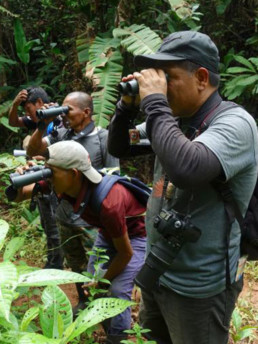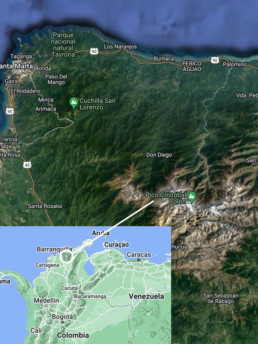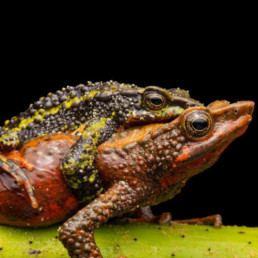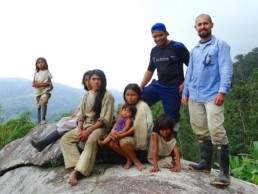Location
The Sierra Nevada de Santa Marta in the Caribbean region of Colombia
Goal
To advance the conservation of threatened species of Harlequin Toads.
Project Field Partner
Fundación Atelopus is dedicated to promoting and supporting the conservation of ecosystems and associated fauna, with a special focus on protecting amphibians and reptiles. Their efforts are centered on developing interdisciplinary research to ensure benefits for ecosystems and their local communities. They are focused on the research and conservation of amphibians and reptiles and work closely with local communities, providing effective solutions to promote sustainable development in the region.
Size of Area Involved
2,520 km2
A safe haven high in the mountains
The Sierra Nevada de Santa Marta (SNSM), classified as a Key Biodiversity Area, appears to be the only place in the Americas with stable populations of high-altitude Harlequin Toads — the world’s most threatened genus of amphibians. The SNSM is home to 5 threatened endemic Atelopus species, including the Critically Endangered Starry Night Toad (A. arsyecue) and the Endangered Santa Marta Harlequin Toad (A. laetissimus). It is also home to 17 other endemic species of amphibians and at least 2 more species of Atelopus that are in the process of being described. The reasons these stable populations of high-altitude Harlequin Toads occur here are largely unknown.
Reaching 5,775 m, SNSM is the highest coastal mountain in the world. Its elevational amplitude, isolation, and tropical location have conferred biological and hydrological importance. SNSM ecosystems encompass tropical dry forests (one of the most threatened ecosystems in the Neotropics), montane forests and páramos that supply drinking water to two million people in the departments (provinces) of Magdalena, Cesar, and La Guajira.

Starry Night Harlequin Toad
Santa Marta Harlequin Toad
San Lorenzo Harlequin Frog
Threats:
Disease transmission by the Batrachochytrium dendrobatidis (Bd) fungus and habitat degradation/conversion due to livestock and agricultural activities, water pollution, and unsustainable tourism practices are the main drivers behind the extinction or endangerment of many Harlequin Toads (81% of Atelopus species are classified as Endangered or Critically Endangered).
Connecting forests
Key actions are to assess and monitor the population dynamics and threats to two endemic species of Harlequin Toads, and to design and develop conservation strategies with local communities. In 2022 Fundación Atelopus did eight surveys in the rural community of San Pedro de la Sierra to evaluate the population dynamics and epidemiological status (Bd fungus) of the Endangered Santa Marta Harlequin Toad (Atelopus laetissimus) and the Endangered San Lorenzo Harlequin Toad (Atelopus nahumae). In addition, Fundación Atelopus is working toward increasing connectivity between forest patches through reforestation, negotiating restrictive land use agreements with farm owners to reduce impacts of grazing and deforestation in critical areas adjacent to breeding streams, and promoting community awareness.






